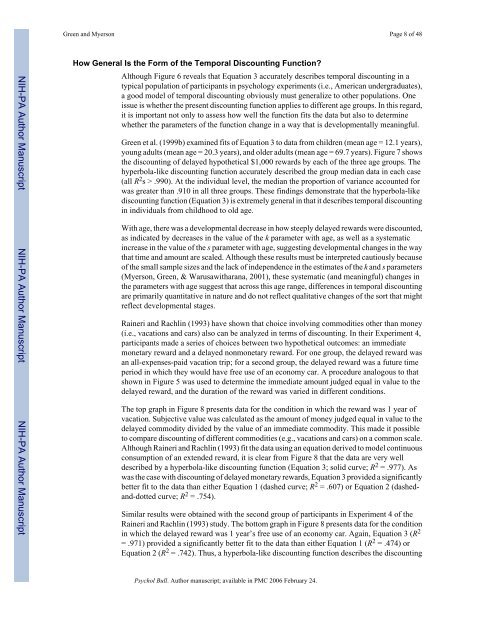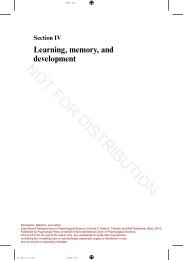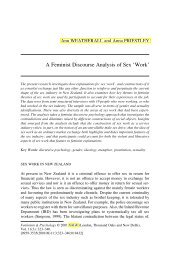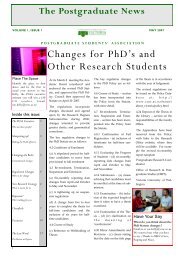green & myerson 2004.. - of /courses
green & myerson 2004.. - of /courses
green & myerson 2004.. - of /courses
You also want an ePaper? Increase the reach of your titles
YUMPU automatically turns print PDFs into web optimized ePapers that Google loves.
Green and Myerson Page 8 <strong>of</strong> 48<br />
NIH-PA Author Manuscript NIH-PA Author Manuscript NIH-PA Author Manuscript<br />
How General Is the Form <strong>of</strong> the Temporal Discounting Function?<br />
Although Figure 6 reveals that Equation 3 accurately describes temporal discounting in a<br />
typical population <strong>of</strong> participants in psychology experiments (i.e., American undergraduates),<br />
a good model <strong>of</strong> temporal discounting obviously must generalize to other populations. One<br />
issue is whether the present discounting function applies to different age groups. In this regard,<br />
it is important not only to assess how well the function fits the data but also to determine<br />
whether the parameters <strong>of</strong> the function change in a way that is developmentally meaningful.<br />
Green et al. (1999b) examined fits <strong>of</strong> Equation 3 to data from children (mean age = 12.1 years),<br />
young adults (mean age = 20.3 years), and older adults (mean age = 69.7 years). Figure 7 shows<br />
the discounting <strong>of</strong> delayed hypothetical $1,000 rewards by each <strong>of</strong> the three age groups. The<br />
hyperbola-like discounting function accurately described the group median data in each case<br />
(all R 2 s > .990). At the individual level, the median the proportion <strong>of</strong> variance accounted for<br />
was greater than .910 in all three groups. These findings demonstrate that the hyperbola-like<br />
discounting function (Equation 3) is extremely general in that it describes temporal discounting<br />
in individuals from childhood to old age.<br />
With age, there was a developmental decrease in how steeply delayed rewards were discounted,<br />
as indicated by decreases in the value <strong>of</strong> the k parameter with age, as well as a systematic<br />
increase in the value <strong>of</strong> the s parameter with age, suggesting developmental changes in the way<br />
that time and amount are scaled. Although these results must be interpreted cautiously because<br />
<strong>of</strong> the small sample sizes and the lack <strong>of</strong> independence in the estimates <strong>of</strong> the k and s parameters<br />
(Myerson, Green, & Warusawitharana, 2001), these systematic (and meaningful) changes in<br />
the parameters with age suggest that across this age range, differences in temporal discounting<br />
are primarily quantitative in nature and do not reflect qualitative changes <strong>of</strong> the sort that might<br />
reflect developmental stages.<br />
Raineri and Rachlin (1993) have shown that choice involving commodities other than money<br />
(i.e., vacations and cars) also can be analyzed in terms <strong>of</strong> discounting. In their Experiment 4,<br />
participants made a series <strong>of</strong> choices between two hypothetical outcomes: an immediate<br />
monetary reward and a delayed nonmonetary reward. For one group, the delayed reward was<br />
an all-expenses-paid vacation trip; for a second group, the delayed reward was a future time<br />
period in which they would have free use <strong>of</strong> an economy car. A procedure analogous to that<br />
shown in Figure 5 was used to determine the immediate amount judged equal in value to the<br />
delayed reward, and the duration <strong>of</strong> the reward was varied in different conditions.<br />
The top graph in Figure 8 presents data for the condition in which the reward was 1 year <strong>of</strong><br />
vacation. Subjective value was calculated as the amount <strong>of</strong> money judged equal in value to the<br />
delayed commodity divided by the value <strong>of</strong> an immediate commodity. This made it possible<br />
to compare discounting <strong>of</strong> different commodities (e.g., vacations and cars) on a common scale.<br />
Although Raineri and Rachlin (1993) fit the data using an equation derived to model continuous<br />
consumption <strong>of</strong> an extended reward, it is clear from Figure 8 that the data are very well<br />
described by a hyperbola-like discounting function (Equation 3; solid curve; R 2 = .977). As<br />
was the case with discounting <strong>of</strong> delayed monetary rewards, Equation 3 provided a significantly<br />
better fit to the data than either Equation 1 (dashed curve; R 2 = .607) or Equation 2 (dashedand-dotted<br />
curve; R 2 = .754).<br />
Similar results were obtained with the second group <strong>of</strong> participants in Experiment 4 <strong>of</strong> the<br />
Raineri and Rachlin (1993) study. The bottom graph in Figure 8 presents data for the condition<br />
in which the delayed reward was 1 year’s free use <strong>of</strong> an economy car. Again, Equation 3 (R 2<br />
= .971) provided a significantly better fit to the data than either Equation 1 (R 2 = .474) or<br />
Equation 2 (R 2 = .742). Thus, a hyperbola-like discounting function describes the discounting<br />
Psychol Bull. Author manuscript; available in PMC 2006 February 24.






